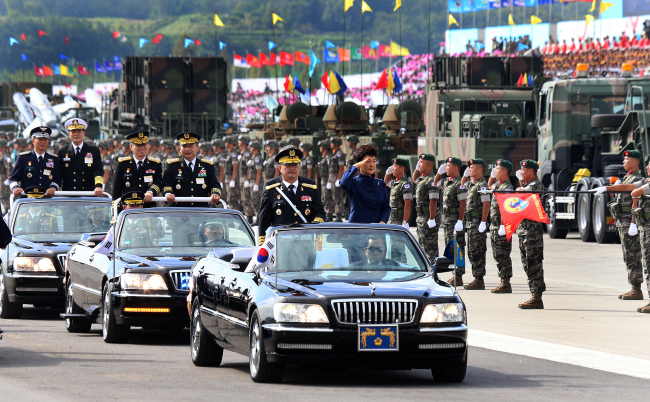President Park Geun-hye on Tuesday vowed to step up efforts for stronger deterrence until Pyongyang made the “right” choice for peninsular peace, as Seoul marked the 65th anniversary of the founding of its armed forces.
During Seoul’s largest military parade in a decade, Park said Seoul would strive to quickly acquire key assets, including a low-tier missile defense system, to counter threats from North Korea’s nuclear arms and other weapons of mass destruction.
 |
President Park Geun-hye and military leaders inspect the military during Tuesday’s Armed Forces Day parade at Seoul Air Base in Seongnam, Gyeonggi Province. (Chung Hee-cho/The Korea Herald) |
“The current security environment surrounding the Korean Peninsula and Northeast Asia is very grave. The North has been gradually upgrading its nuclear capabilities,” Park said during the parade at Seoul Airport in Seongnam, Gyeonggi Province.
“I believe that the genuine value of the military lies not in waging war, but on deterring war. … I will make the North Korean regime recognize that the nuclear arms and missiles it has been constantly pursuing are no longer useful.”
For the military event, also attended by U.S. Defense Secretary Chuck Hagel and U.S. Joint Chiefs of Staff Chairman Gen. Martin Dempsey, some 11,000 troops, 120 aircraft and 190 ground-based military weapons systems were mobilized.
For the first time, the military revealed the Hyunmu-II ballistic missile with a range of 300 km and the Hyunmu-III cruise missile with a range of 1,000 km, both of which are capable of striking key military targets in the North.
It also unveiled the Israeli-made Spike missile with a range of 20 km, which is capable of launching precision strikes on artillery pieces on the western coast of the communist state.
During the parade, Park pledged to quickly establish the “Kill Chain” system and the Korea Air and Missile Defense program.
The Kill Chain system is Seoul’s preemptive strike apparatus. Mobilizing all intelligence, reconnaissance and surveillance assets of the South Korea-U.S. combined forces, the system is designed to launch strikes quickly after signs are detected of an imminent nuclear or missile provocation by Pyongyang.
The KAMD is a low-tier missile defense program to counter Pyongyang’s missile threats. Seoul has long argued that it is different from the U.S.-led global multilayered missile defense program in consideration of its relations with Beijing.
“With strong security that does not allow for any provocations, (we) can encourage North Korea to come out toward the path for genuine change, while maintaining peninsular peace,” said Park.
“The government will usher in a new era of people’s happiness and hope while laying the groundwork step by step for peninsular peace and reunification, based on robust security.”
Her remarks apparently reaffirmed that her government would step up its push for her signature “peninsular trust-building process,” through which she vowed to continue dialogue with the North to address bilateral issues while maintaining strong deterrence.
Meanwhile, U.S. JCS Chairman Dempsey visited the Seoul National Cemetery to pay respects to South Korean war dead earlier in the day.
The allies’ defense ministers and their top military officials are to meet on Wednesday for their annual Security Consultative Meeting, where Seoul’s request to reconsider the timing of the transfer of wartime operational control is expected to top the agenda.
During the SCM, the allies are also expected to finalize their “tailored” deterrence strategy against North Korea’s nuclear arms and other weapons of mass destruction.
By Song Sang-ho
(
sshluck@heraldcorp.com)








